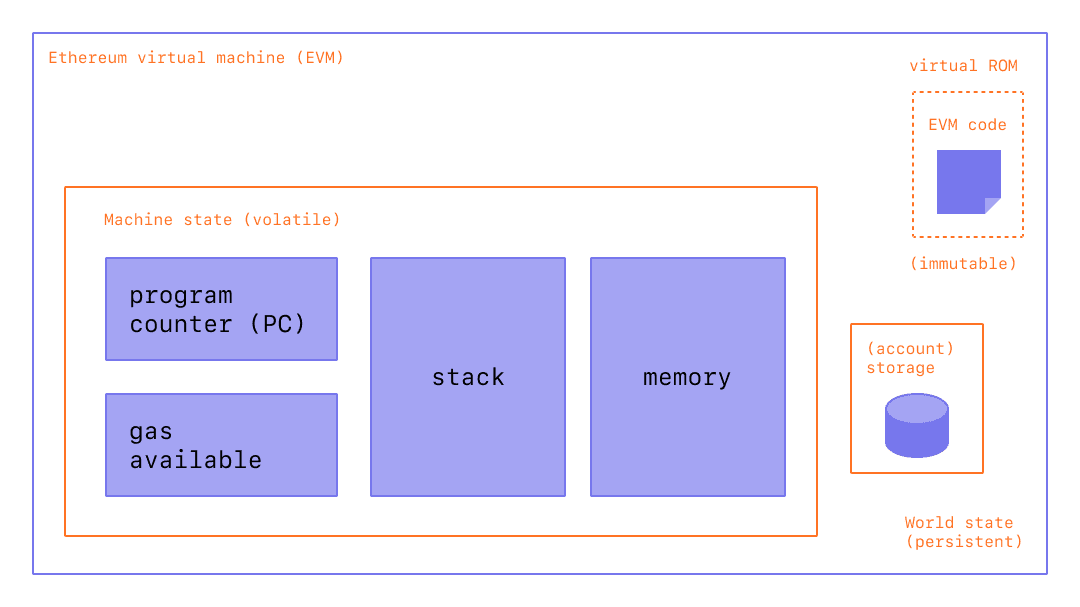xdagj
 xdagj copied to clipboard
xdagj copied to clipboard
Feature : EVM Support
The biggest source of Ethereum on the chain and the success of smart contracts, we see that the key to the success of the Ethereum ecosystem is the creation of an EVM virtual machine. At present, the realization of a virtual machine is very important for XDAG. The reasons are as follows:
- The throughput of Ethereum L1 15 tps/s causes high handling fees (>10$), which greatly limits the development of DAPP
- Ethereum 2.0 POS has not yet determined the specific launch date, which has a great degree of delay risk and security risk (the topic of POW vs POS is a cliché, not to argue here, but we believe that POW is more secure)
- XDAG has a natural high TPS design, and POW safety design, and has a good foundation for the development of higher performance DAPP
EVM Illustrated

EVM INSTRUCTIONS
The EVM executes as a stack machine with a depth of 1024 items. Each item is a 256-bit word, which was chosen for the ease of use with 256-bit cryptography (such as Keccak-256 hashes or secp256k1 signatures).
During execution, the EVM maintains a transient memory (as a word-addressed byte array), which does not persist between transactions.
Contracts, however, do contain a Merkle Patricia storage trie (as a word-addressable word array), associated with the account in question and part of the global state.
Compiled smart contract bytecode executes as a number of EVM opcodes, which perform standard stack operations like XOR, AND, ADD, SUB, etc. The EVM also implements a number of blockchain-specific stack operations, such as ADDRESS, BALANCE, KECCAK256, BLOCKHASH, etc.

How to calculate the gas cost of XDAG and the fee of the transaction?
How to calculate the gas cost of XDAG and the fee of the transaction?
1.Define the smallest unit of xdag gas Sub-units of Ether:
| Unit | wei value | wei | ether value |
|---|---|---|---|
| wei | 1 wei | 1 | 10^-18 ETH |
| kwei | 10^3 wei | 1,000 | 10^-15 ETH |
| mwei | 10^6 wei | 1,000,000 | 10^-12 ETH |
| gwei | 10^9 wei | 1,000,000,000 | 10^-9 ETH |
| microether | 10^12 wei | 1,000,000,000,000 | 10^-6 ETH |
| milliether | 10^15 wei | 1,000,000,000,000,000 | 10^-3 ETH |
| ether | 10^18 wei | 1,000,000,000,000,000,000 | 1 ETH |
Sub-units of Xdager:
| Unit | nano value | nano | xdager value |
|---|---|---|---|
| NANO_XDAG | 1 NANO_XDAG | 1 | 10^-9 XDAG |
| MICRO_XDAG | 10^3 NANO_XDAG | 1,000 | 10^-6 XDAG |
| MILLI_XDAG | 10^6 NANO_XDAG | 1,000,000 | 10^-3 XDAG |
| XDAG | 10^9 NANO_XDAG | 1,000,000,000 | 1 XDAG |
For ease of use, we tentatively set (1 NANO_XDAG == 1 wei)
2.Each OP_CODE Standard Gas Prices
3.Estimating transaction costs
| Name | Mean |
|---|---|
| Gas Price | price (in ether) of one unit of gas specified in the transaction |
| Gas Used | is the total gas that is consumed by the transaction |
Total cost = gasUsed * gasPrice
4.ERC-20 Token Gas for Example
| Name | Token | Gas Price | Gas Used | ALL Gas |
|---|---|---|---|---|
| ETH | ERC-20(USDT) | 0.000000008 Ether | 3,170,794 | 0.025366352 |
Fair Price Calculation: ETH and XDAG Prices refer to market prices on Coinmarketcap at 2021-06-24
| Gas Price | ERC20 Cost | $ Prices | $ Total Price | % |
|---|---|---|---|---|
| 0.000000008 Ether | 0.025366352 Ether | $ 1,928.72 / 1 ETH | $ 48 | 100% |
| 0.000008000 Xdager | 25.36635200 Xdager | $ 0.00284 / 1 XDAG | $ 0.072 | 0.15 % |
It is planned to stabilize the network first, improve network stability, and then support for evm
Is the plan still ongoing?
Is the plan still ongoing?
https://github.com/XDagger/xdagj/issues/230
Please read this article, I think there are too many chains about evm, and it is too complicated for community projects, we are looking for a more suitable way for XDAG to realize defi capabilities